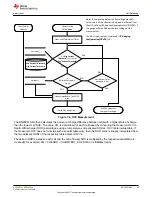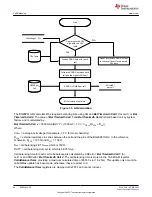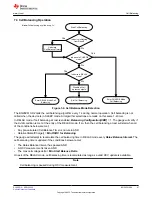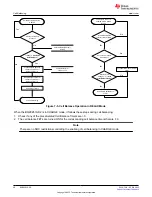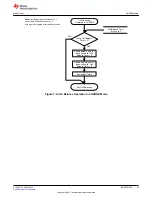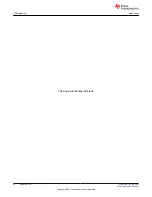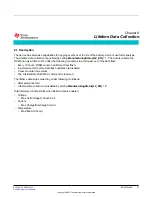
RSOC status and starts the function when either condition is met. The RSOC and cell voltage setting can be
configured through
Fast Scale Start SOC
or
Term Voltage
.
If
[FF_NEAR_EDV]
: Fast Filter Near EDV. If this flag is set, the gauge applies an alternative filter,
Near EDV Ra
Param Filter
, for an Ra update in the fast scaling region (starting around 105 RSOC). This flag should be kept to
1 as a default. When this flag is 0, the gauge uses the regular Ra filter,
Resistance Parameter Filter
. Both DF
filters should not be changed from the default value.
[SMOOTH]
: A change in temperature or current rate can cause a significant change in Remaining Capacity
(RemCap), and therefore results in a jump or drop in the Relative State-of-Charge (RSOC). This function
provides an option to prevent an RSOC jump or drop during charge and discharge.
If a jump or drop of RSOC occurs, the device examines the amount of the RSOC jump or drop versus the
expected end point (that is, the charge termination for the charging condition or the EDV for the discharge
condition) and automatically smooths the change of RSOC, and always converges with the filtered (or
smoothed) value to the actual charge termination or EDV point. The actual and filtered values are always
available. The
[SMOOTH]
flag selects either the actual or filtered values as a returned SBS command.
[RELAX_JUMP_OK]: If set to
1, this flag enables the RSOC to jump during RELAX mode. Otherwise, RSOC
holds constant during RELAX mode and any RSOC jump will be passed into the onset of the charge or
discharge phase.
[CELL_TERM]
: This flag provides an option to calculate discharge termination based on cell voltage instead of
pack voltage when this bit set, . If the minimum cell voltage reaches
Term Min Cell V
,
RemainingCapacity()
will
be forced to 0 mAh.
[CSYNC]
: This flag, if set to 1, synchronizes
FullChargeCapacity()
at valid charge termination.
[CCT]
: This flag provides an option to use
FullChargeCapacity()
(when
[CCT]
= 1) or
DesignCapacity()
(when
[CCT]
= 0) for cycle count threshold calculation. The minimum cycle count threshold is always 10% of Design
capacity even if
FullChargeCapacity()
is selected for cycle count threshold calculation. This helps to avoid any
erroneous cycle count increment caused by an extremely low
FullChargeCapacity()
.
6.7 State-of-Health (SOH)
The device now implements an updated version of the battery state-of-health (SOH), which is reported by the
StateofHealth()
command. In the previous version, the
StateofHealth()
was calculated using a special 25°C
version of
FullChargeCapacity
as a fraction of
Design Capacity
. However, this calculation still included some
parameters that were updated during operation based on the loading and use of the battery, separate from the
battery status itself. This could lead to varying calculations of state-of-health for the same battery, depending
on how the battery was used in system. The updated version of
StateofHealth()
addresses this by calculating
a special SOH Full Charge Capacity, with the initial ambient temperature fixed at 25°C, using a current load
specified by
SOH Load Rate
, and using the thermal model parameters,
SOH Temp a
and
SOH Temp k
.
The
SOH Load Rate
can be set to the typical current of the application, and it is specified in units of hour-rate
(that is,
Design Capacity
/
SOH Load Rate
will be the current used for the SOH simulation). The
SOH Temp
a
and
SOH Temp k
can be set to expected values for the system during operation. These data flash settings
are used only for the
StateofHealth()
calculation. This SOH Full Charge Capacity is updated whenever ASOC
and RSOC are updated. Because this implementation removes the variation of load current, temperature, and
learned parameters, it is a better representation of the battery's state-of-health. The SOH Full Charge Capacity
is available on the MAC command
FCC_SOH()
.
Gauging
42
BQ28Z610-R2
Copyright © 2022 Texas Instruments Incorporated


















